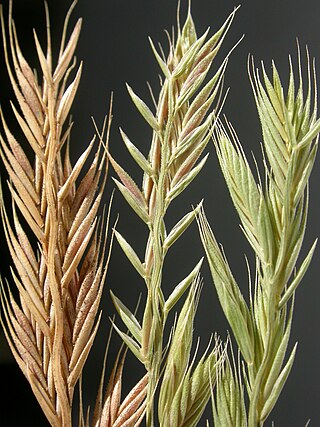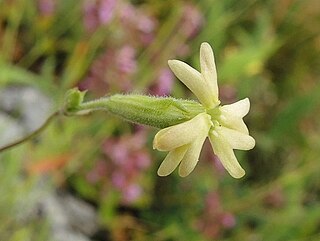
Lomelosia prolifera, the Carmel daisy, is a flowering plant of the family Caprifoliaceae. Its flowers in February to May, are creamy yellow, and when the petals are shed they leave a greenish-looking dried flower, good for arrangements. It is native to the eastern Mediterranean.

Pallenis is a small genus of flowering plants in the tribe Inuleae within the family Asteraceae. The name is derived from palea (chaff), referring to the chaffy receptacle.

Anthemis is a genus of aromatic flowering plants in the family Asteraceae, closely related to Chamaemelum, and like that genus, known by the common name chamomile; some species are also called dog-fennel or mayweed. Anthemis are native to the Mediterranean region and southwest Asia east to Iran. A number of species have also become naturalized in the United Kingdom and other parts of the world.

The genus Carthamus, the distaff thistles, includes plants in the family Asteraceae. The group is native to Europe, North Africa, and parts of Asia. The flower has been used since ancient times in the Philippines, which it has been called kasubha by the Tagalog people.

Globularia is a genus of about 22 species of flowering plants in the family Plantaginaceae, native to central and southern Europe, Macaronesia, northwest Africa and southwest Asia. They are dense low evergreen mat-forming perennials or subshrubs, with leathery oval leaves 1–10 cm long. The flowers are produced in dense inflorescences (capitula) held above the plant on a 1–30 cm tall stem; the capitula is 1–3 cm in diameter, with numerous tightly packed purple, violet, pink or white flowers.

Lomelosia caucasica, the Caucasian pincushion flower, pincushion-flower or Caucasian scabious, is a species of flowering plant in the family Caprifoliaceae, native to the Caucasus, north eastern Turkey, and northern Iran. Growing to 60 cm (24 in) tall and broad, it is a clump-forming perennial with grey-green, divided leaves. Pincushion-shaped buds, borne on erect hairy, stems, open to pale blue or lavender flower heads, 4–8 cm (2–3 in) in diameter, from late summer through to autumn.

Ptilostemon is a genus of plants in the tribe Cardueae within the family Asteraceae.

Filago is a genus of plants in the sunflower family, native from Europe and northern Africa to Mongolia, Nepal, and Macaronesia. They are sometimes called cottonroses or cudweeds.

Vulpia is a widespread genus of plants in the grass family, native to many countries around the world and naturalized in many of the nations to which it is not native. It is most common in temperate regions.

Parietaria is a genus of flowering plants in the family Urticaceae, native to temperate and tropical regions across the world.

Bethencourtia is a genus of flowering plants in the daisy family, Asteraceae. It contains three species of plants endemic to the Canary Islands.

Brachanthemum is a genus of flowering plants in the aster family, Asteraceae. They are native to Asia.

Scorzoneroides autumnalis, commonly called autumn hawkbit, is a perennial plant species, widespread in its native range in Eurasia, and introduced in North America.

Rhaponticum scariosum, common name giant scabiosa, is a perennial herbaceous flowering plant of the genus Rhaponticum of the family Asteraceae.

Asyneuma is a genus of flowering plants in the bellflower family, Campanulaceae. They are native to North Africa and Eurasia. Many are endemic to Turkey. Plants of the genus may be known commonly as harebells, but this name can also apply to the entire family. There are up to about 33 species.

Klasea pusilla, is a species in the genus Klasea. It is a native of the Eastern Mediterranean.

Psephellus is a genus of flowering plants in the family Asteraceae, native to eastern Europe and western Asia. A taxonomic revision reassigned many species from Centaurea to Psephellus.

Silene flavescens are flowering plants part of the genus Silene, family Caryophyllaceae. They are widely distributed and are found in the northern hemisphere. They are native to Hungary and the Balkan Peninsula. It is an herbaceous species belonging to the tribe Sileneae

Huynhia is a genus of flowering plants belonging to the family Boraginaceae, from Asia.

Lomelosia is a genus of flowering plant in the family Caprifoliaceae and the subfamily of Dipsacoideae. The genus includes over 50-63, perennial and annual species, diffused around the Mediterranean Sea, with the greatest diversity of species concentrated in the eastern Mediterranean and the Middle East, and also has a few species reaching as far east as China.



















